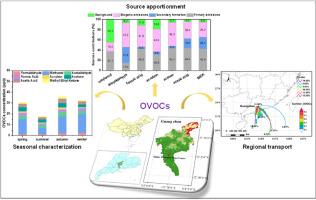PTR-QMS observation of OVOCs in an urban suburb of Guangzhou: seasonal characterization, source apportionment and regional transport
IF 3.7
2区 环境科学与生态学
Q2 ENVIRONMENTAL SCIENCES
引用次数: 0
Abstract
Understanding pollution, source and effect of oxygenated volatile organic compounds (OVOCs) is crucial for improving air quality in urban suburbs. This study utilized a proton-transfer-reaction quadrupole mass spectrometer to investigate OVOC pollution characteristics and environmental impacts across four seasons (2022–2023) in an urban suburb of Guangzhou. Results showed that OVOCs dominated total VOCs (averaging 75.4 %), with methanol, acetone, formaldehyde, and carboxylic acids as predominant species. These compounds significantly contributed to ozone formation potential (40.6 %–60.3 %) and OH reactivity. OVOC concentrations exhibited a distinct seasonal pattern (spring > autumn > winter > summer), influenced by photochemical processes and regional transport. Diurnal variations indicated that methanol peaked in the morning and evening linked to primary emissions, while aldehydes and ketones peaked in the afternoon due to secondary formation. Carboxylic acids displayed complex multi-peak patterns with significant nighttime accumulation, correlating with PM2.5 and suggesting a key role in secondary organic aerosol formation. Photochemical age-based source apportionment revealed diverse contributions: primary emissions were crucial for methanol, methyl ethyl ketone, and acetic acid; secondary formation was important for acetaldehyde, methyl ethyl ketone, and acetic acid; biogenic emissions contributed to formic acid, acetaldehyde, acrolein, and acetone; and background sources impacted methanol in colder seasons. Trajectory clustering and potential source contribution function analyses identified seasonally modulated transport patterns influencing the source areas of OVOCs, PM2.5 and O3. The study highlights OVOCs as key drivers of O3 and SOA formation in urban suburb, while effective mitigation of photochemical pollution in such area requires a multi-faceted control strategy that not only targets local primary precursors (e.g., from traffic and solvents) but also incorporates regionally coordinated efforts to address seasonally varying transboundary pollution.

广州城郊OVOCs的PTR-QMS观测:季节特征、来源解析和区域运输
了解含氧挥发性有机化合物(OVOCs)的污染、来源及其影响对改善城市郊区空气质量至关重要。本研究利用质子转移反应四极杆质谱仪研究了广州城郊4个季节(2022-2023年)OVOC污染特征及其对环境的影响。结果表明:挥发性有机化合物(OVOCs)占总挥发性有机化合物(VOCs)的主导地位(平均为75.4%),甲醇、丙酮、甲醛和羧酸是主要挥发性有机化合物;这些化合物显著影响臭氧形成势(40.6% - 60.3%)和OH反应性。OVOC浓度受光化学过程和区域运输的影响,呈现出明显的季节分布(春、秋、冬、夏)。日变化表明,与一次排放有关的甲醇在早上和晚上达到峰值,而由于二次排放,醛和酮在下午达到峰值。羧酸表现出复杂的多峰模式,夜间积累显著,与PM2.5相关,表明在二次有机气溶胶形成中起关键作用。基于光化学年龄的源分配揭示了不同的贡献:一次排放对甲醇、甲基乙基酮和乙酸至关重要;乙醛、甲乙基酮和乙酸的二次生成是重要的;生物源排放产生甲酸、乙醛、丙烯醛和丙酮;背景源在较冷的季节影响甲醇。轨迹聚类分析和潜在源贡献函数分析确定了影响OVOCs、PM2.5和O3源区的季节调节运输模式。该研究强调,OVOCs是城市郊区形成O3和SOA的关键驱动因素,而有效缓解该地区的光化学污染需要多方面的控制策略,不仅针对当地的主要前体(例如,来自交通和溶剂),而且还包括区域协调努力,以解决季节性变化的跨界污染。
本文章由计算机程序翻译,如有差异,请以英文原文为准。
求助全文
约1分钟内获得全文
求助全文
来源期刊

Atmospheric Environment
环境科学-环境科学
CiteScore
9.40
自引率
8.00%
发文量
458
审稿时长
53 days
期刊介绍:
Atmospheric Environment has an open access mirror journal Atmospheric Environment: X, sharing the same aims and scope, editorial team, submission system and rigorous peer review.
Atmospheric Environment is the international journal for scientists in different disciplines related to atmospheric composition and its impacts. The journal publishes scientific articles with atmospheric relevance of emissions and depositions of gaseous and particulate compounds, chemical processes and physical effects in the atmosphere, as well as impacts of the changing atmospheric composition on human health, air quality, climate change, and ecosystems.
 求助内容:
求助内容: 应助结果提醒方式:
应助结果提醒方式:


